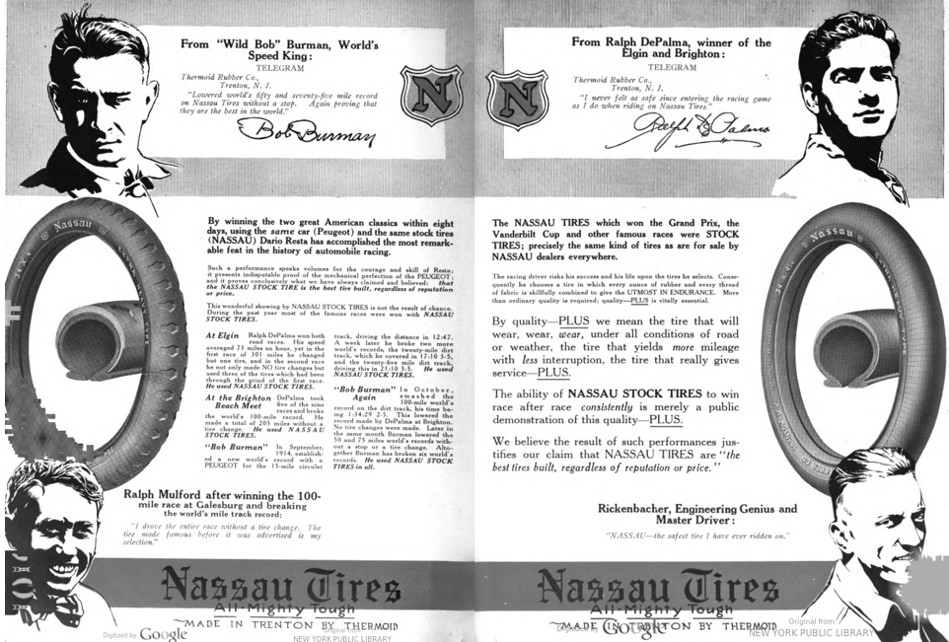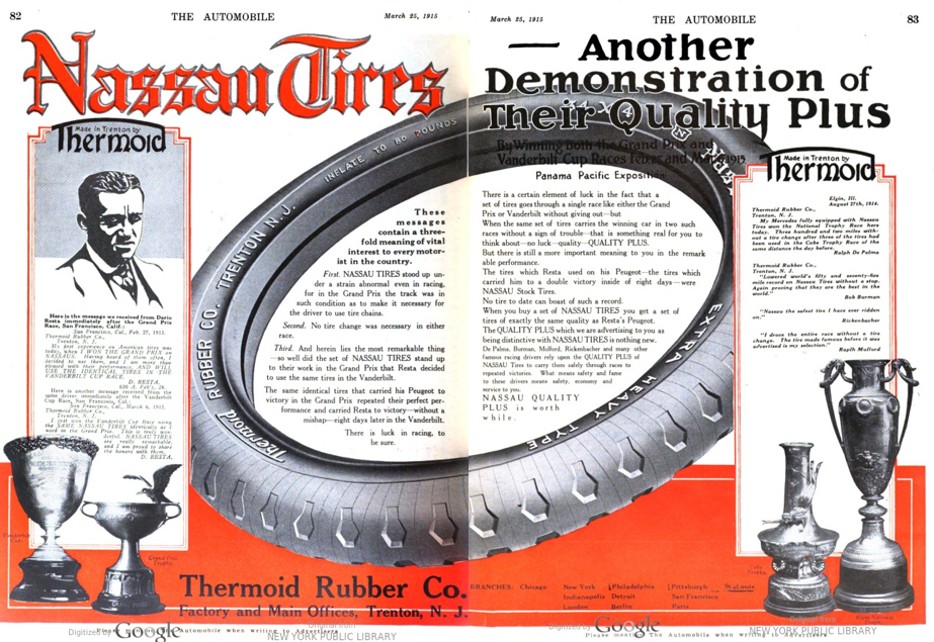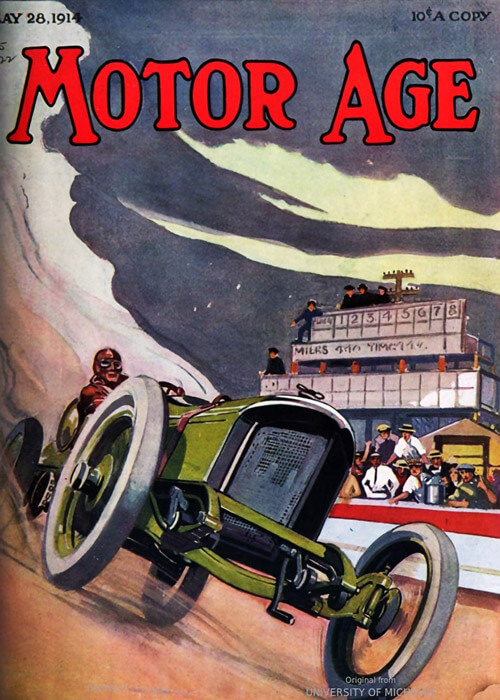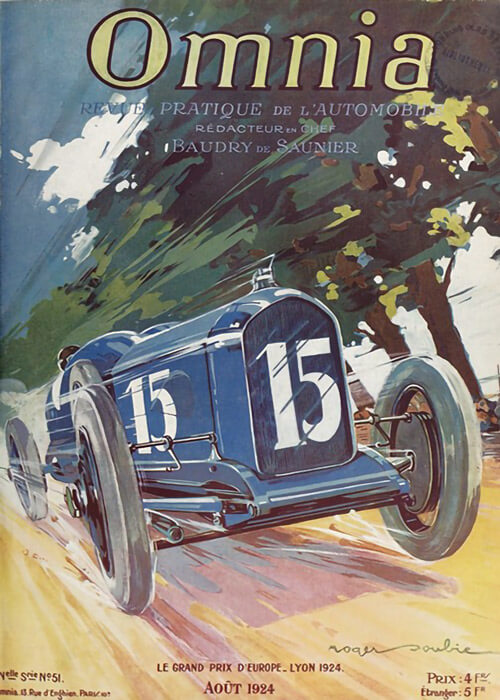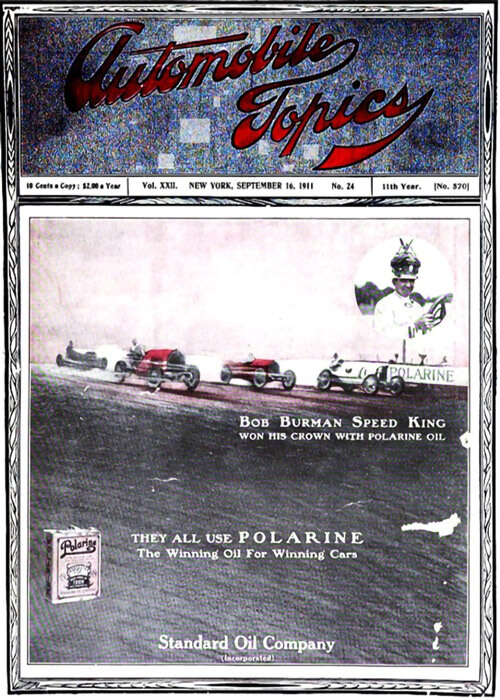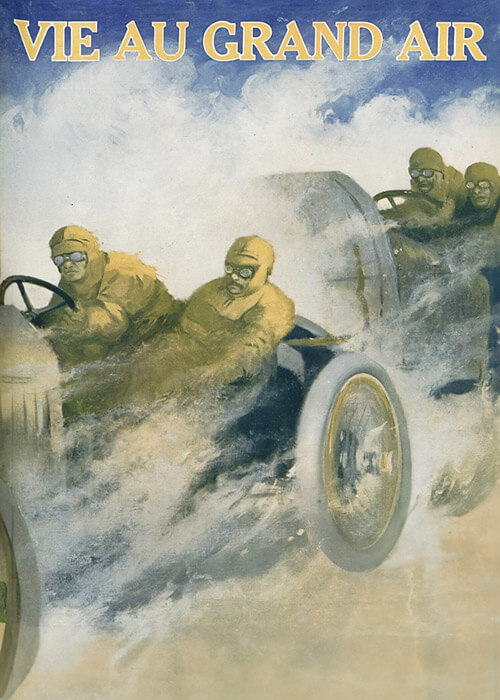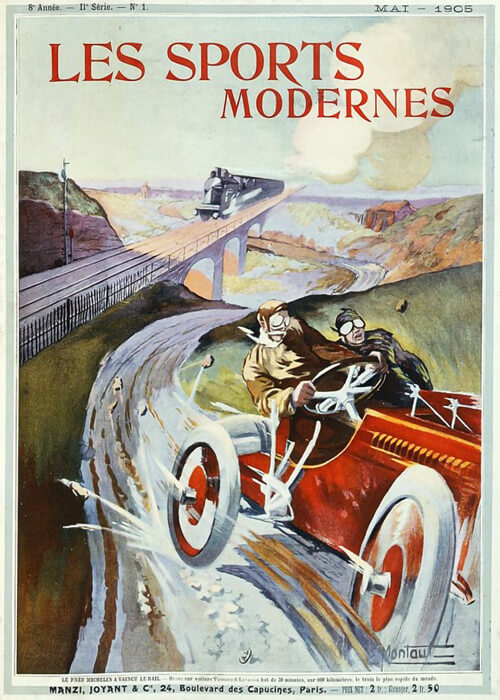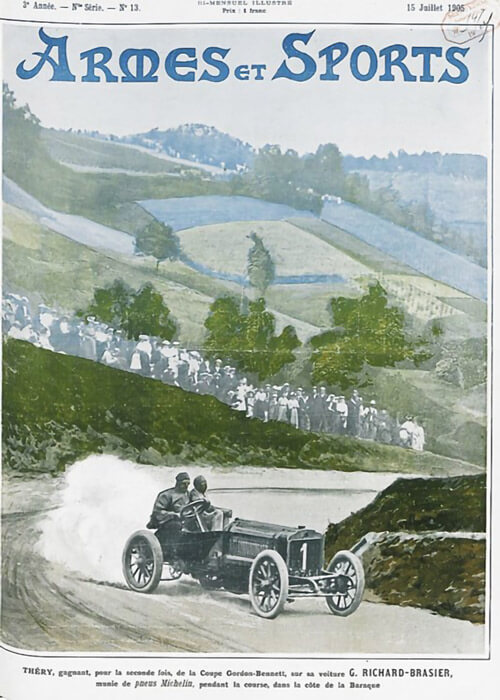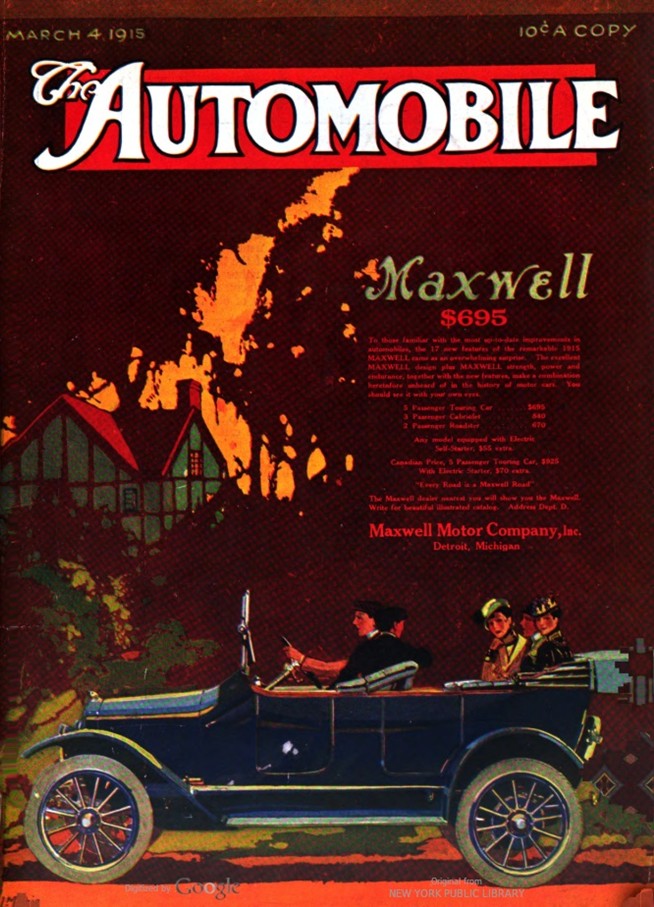
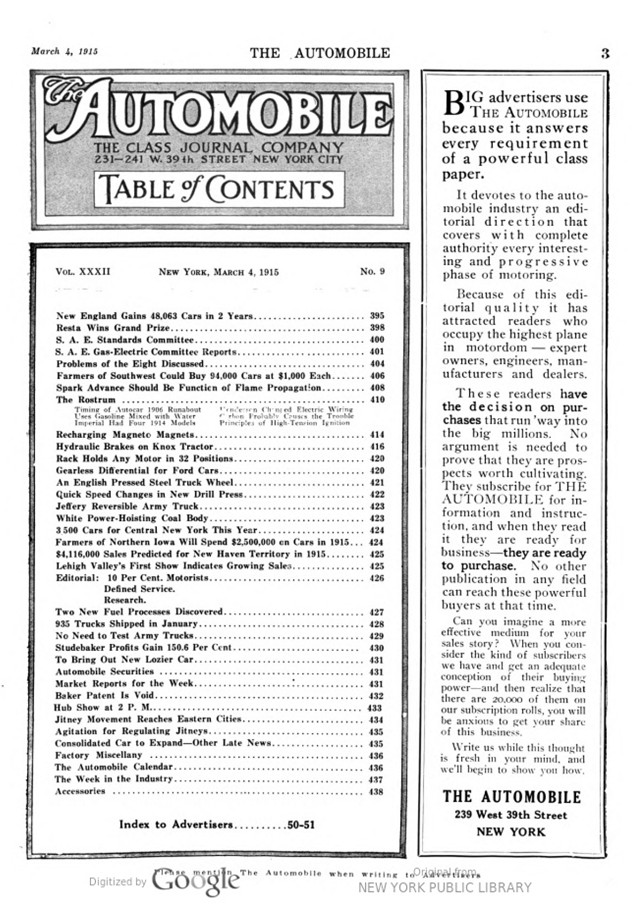

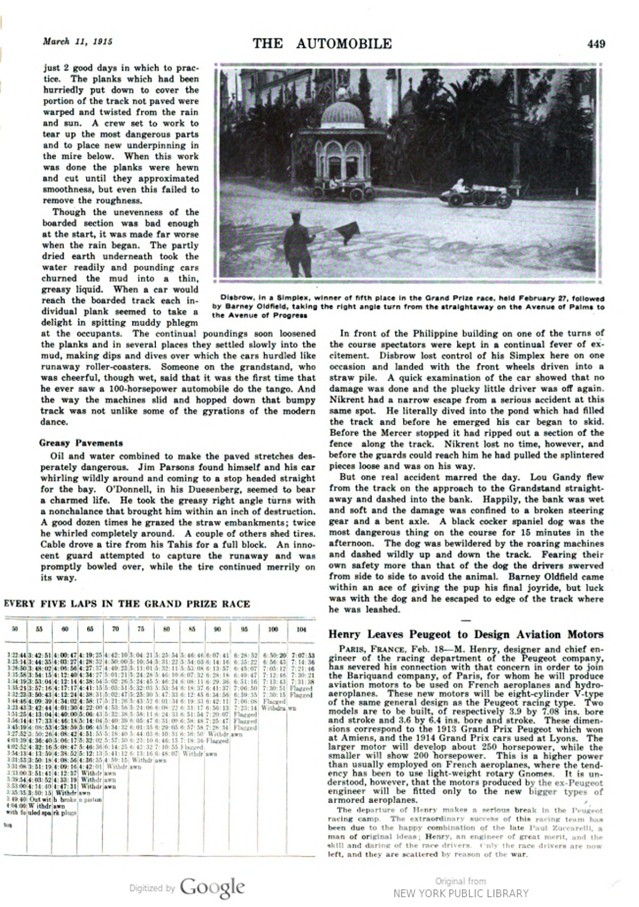
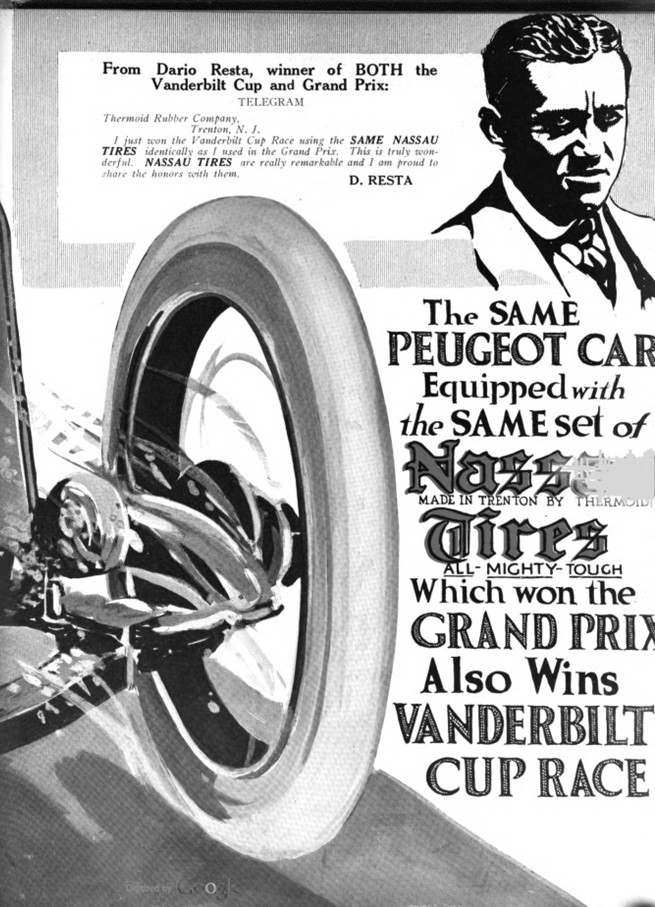
Text and photos with courtesy of hathitrust.org, compiled by motorracingistory.com
The Automobile Vol. 32, Jan-March 1915, No. 10, March 11, 1915, pages 448 – 449
The Winning of the Grand Prize
How Resta, the Dark Horse, Took the Race – A Speed Duel with Death – Thrills on Every Lap
By A. G. Waddell
SAN FRANCISCO, CAL., March 2 – The clicking of the telegraph instruments in the press stand stopped for a moment, and in the pause an operator leaned back in his chair and said, „Gee, he was a fifty to one shot before the race! Resta certainly fooled me.“
The words of this operator sum up the condition of mind of half of those who saw a comparatively unknown, and at least unheralded driver, carry away one of the most coveted cups of the automobile racing world. But not a soul who saw the nervy, skillful driving of the English-Italian had aught but praise for him. His skill was acknowledged; it was too evident to be otherwise. But the real admiration of the crowd was of a different sort. It was similar to the admiration of a small boy for the man who leaps the gap on a bicycle. It was a mixture of wonder and amazement at the audacity of the driver whose fearlessness carried him at breakneck speed over a course where death continually lurked.
How Resta Felt
Resta very naively says, „In such rotten weather the course was hard to drive.“ He might have said much more. might have told of the terrible beating of the rain in his eyes and face, for water coming with a 57-mile head has a sting to it. He might have said something of the sensation of driving through a lake at close to a mile a minute pace and of the regular drenchings which came with each lap. There are many things each driver who stayed fifty laps could tell, but Resta merely says „the course was hard to drive.“ No wonder Resta is the hero of San Francisco.
True, he had good luck. He came to the pit but twice, once for gasoline and oil, again to change to non-skid tires. He made no mechanical adjustments and the car was running as sweetly at the finish as at the start.
But in this sort of race it is not the machines which interest so much, for they hardly had a chance to warm themselves by speed, but it is the human being who can endure hour after hour and give every vestige of his strength to the gamble between winning speed and lurking death. That is what lends the human touch and that is what makes the remembrance of the race rest not alone with one car or another but with the men who stayed in. It was not so much a race of cars and speed as it was a race of men. The man who was willing to take the most chances and who had the stamina and strength to withstand the cold and beating rain looms far greater in the popular mind than the actual performance of the machines.
The Course
Rain had fallen until 3 days before the race and by the time the course had been put into condition the drivers had just 2 good days in which to practice. The planks which had been hurriedly put down to cover the portion of the track not paved were warped and twisted from the rain and sun. A crew set to work to tear up the most dangerous parts and to place new underpinning in the mire below. When this work was done the planks were hewn and cut until they approximated smoothness, but even this failed to remove the roughness.
Though the unevenness of the boarded section was bad enough at the start, it was made far worse when the rain began. The partly dried earth underneath took the water readily and pounding cars churned the mud into a thin, greasy liquid. When a car would reach the boarded track each individual plank seemed to take a delight in spitting muddy phlegm at the occupants. The continual poundings soon loosened the planks and, in several places, they settled slowly into the mud, making dips and dives over which the cars hurdled like runaway roller-coasters. Someone on the grandstand, who was cheerful, though wet, said that it was the first time that he ever saw a 100-horsepower automobile do the tango. And the way the machines slid and hopped down that bumpy track was not unlike some of the gyrations of the modern dance.
Greasy Pavements
Oil and water combined to make the paved stretches desperately dangerous. Jim Parsons found himself and his car whirling wildly around and coming to a stop headed straight for the bay. O’Donnell, in his Duesenberg, seemed to bear a charmed life. He took the greasy right angle turns with a nonchalance that brought him within an inch of destruction. A good dozen times he grazed the straw embankments; twice he whirled completely around. A couple of others shed tires. Cable drove a tire from his Tahis for a full block. An innocent guard attempted to capture the runaway and was promptly bowled over, while the tire continued merrily on its way.
In front of the Philippine building on one of the turns of the course spectators were kept in a continual fever of excitement. Disbrow lost control of his Simplex here on one occasion and landed with the front wheels driven into a straw pile. A quick examination of the car showed that no damage was done, and the plucky little driver was off again. Nikrent had a narrow escape from a serious accident at this same spot. He literally dived into the pond which had filled the track and before he emerged his car began to skid. Before the Mercer stopped it had ripped out a section of the fence along the track. Nikrent lost no time, however, and before the guards could reach him he had pulled the splintered pieces loose and was on his way.
But one real accident marred the day. Lou Gandy flew from the track on the approach to the Grandstand straight-away and dashed into the bank. Happily, the bank was wet and soft and the damage was confined to a broken steering gear and a bent axle. A black cocker spaniel dog was the most dangerous thing on the course for 15 minutes in the afternoon. The dog was bewildered by the roaring machines and dashed wildly up and down the track. Fearing their own safety more than that of the dog the drivers swerved from side to side to avoid the animal. Barney Oldfield came within an ace of giving the pup his final joyride, but luck was with the dog and he escaped to edge of the track where he was leashed.
Photo Captions – The Automobile
Page 448 – START-FINISH The high-powered racers lined up just before the start of the Grand Prize race at the Panama-Pacific Exposition, February 27
TABLE SHOWING TIMES MADE BY DRIVERS EVERY FIVE LAPS IN THE GRAND PRIZE RACE
Page 449 – Disbrow, in a Simplex, winner of fifth place in the Grand Prize race, held February 27, followed by Barney Oldfield, taking the right angle turn from the straightaway on the Avenue of Palms to the Avenue of Progress
